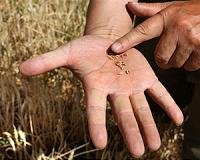 |
Camden NJ (SPX) Oct 26, 2010 Humans are overloading ecosystems with nitrogen through the burning of fossil fuels and an increase in nitrogen-producing industrial and agricultural activities, according to a new study. While nitrogen is an element that is essential to life, it is an environmental scourge at high levels. According to the study, excess nitrogen that is contributed by human activities pollutes fresh waters and coastal zones, and may contribute to climate change. Nevertheless, such ecological damage could be reduced by the adoption of time-honored sustainable practices. Appearing in Science and conducted by an international team of researchers, the study was partially funded by the National Science Foundation.
The Nitrogen Cycle The transformation of biologically useful forms of nitrogen to useful forms of nitrogen is known as nitrogen fixation. Mostly mediated by bacteria that live in legume plant roots and soils, nitrogen fixation and other components of the nitrogen cycle weave and wind through the atmosphere, plants, subsurface plant roots, and soils; the nitrogen cycle involves many natural feedback relationships between plants and microorganisms. According to the Science paper, since pre-biotic times, the nitrogen cycle has gone through several major phases. The cycle was initially controlled by slow volcanic processes and lightning and then by anaerobic organisms as biological activity started. By about 2.5 billion years ago, as molecular oxygen appeared on Earth, a linked suite of microbial processes evolved to form the modern nitrogen cycle.
Human Impacts on the Nitrogen Cycle "Altogether, human activities currently contribute twice as much terrestrial nitrogen fixation as natural sources, and provide around 45 percent of the total biological useful nitrogen produced annually on Earth," says Falkowski. Much of the human contributions of nitrogen into ecosystems come from an 800 percent increase in the use of nitrogen fertilizers from 1960 to 2000. Another problem: Much of nitrogen fertilizer that is used worldwide is applied inefficiently. As a result, about 60 percent of the nitrogen contained in applied fertilizer is never incorporated into plants and so is free to wash out of root zones, and then pollute rivers, lakes, aquifers and coastal areas through eutrophication. (Eutrophication is a process caused by excess nutrients that depletes oxygen in water bodies and ultimately leads to the death of animal life.) In addition, some reactions involving nitrogen release nitrogen oxide into the atmosphere. Nitrogen oxide is a greenhouse gas that has 300 times (per molecule) the warming potential of carbon dioxide. In addition, nitrogen oxide destroys stratospheric ozone, which protects the earth from harmful ultraviolet (UV-B) radiation.
Methods to Reduce Nitrogen Overloading "Through this steady state, excess nitrogen added from human sources will be removed at rates equivalent to rates of addition, without accumulating." But meanwhile, the Earth's population is approaching 7 billion people, and so ongoing pressures for food production are continuing to increase. "There is no way to feed people without fixing huge amounts of nitrogen from the atmosphere, and that nitrogen is presently applied to crop plants very ineffectively." says Falkowski. So unless promising interventions are taken, the damage done by humans to the Earth's nitrogen cycle will persist for decades or centuries. These promising interventions, which would be designed to reduce the need to use fertilizers that add nitrogen to ecological systems, could include: + Using systematic crop rotations that would supply nitrogen that would otherwise be provided by fertilizers; + Optimizing the timing and amounts of fertilizer applications, adopting selected breeding techniques or developing genetically engineered varieties of plants that would increase the efficiency of nitrogen use; + Using traditional breeding techniques to boost the ability of economically important varieties of wheat, barley and rye to interact favorably with the microbial communities associated with plant root systems and do so in ways that enhance the efficiency of nitrogen use. "While the processes of eutrophication have been recognized for many years, only recently have scientists been able to begin placing the anthropogenic processes in the context of an understanding of the broader biogeochemical cycles of the planet," says Robert Burnap, an NSF program director. "This is an important article because it concisely develops this understanding and also provides reasonable predictions regarding the economic and policy dimensions of the problem."
Share This Article With Planet Earth
Related Links Rutgers University Farming Today - Suppliers and Technology
 Russia to lift ban on flour exports
Russia to lift ban on flour exportsMoscow (AFP) Oct 25, 2010 Russia will lift a ban on flour exports on January 1, 2010, while the export embargo on grain will continue, Russian news agencies reported Monday, citing a government decree. The decree, issued October 20 but published Monday, lifts a ban on exports of wheat and wheat-and-rye flour. But it extends a ban on grain exports until June 30, 2011, the RIA Novosti news agency reported. Firs ... read more |
|
| The content herein, unless otherwise known to be public domain, are Copyright 1995-2010 - SpaceDaily. AFP and UPI Wire Stories are copyright Agence France-Presse and United Press International. ESA Portal Reports are copyright European Space Agency. All NASA sourced material is public domain. Additional copyrights may apply in whole or part to other bona fide parties. Advertising does not imply endorsement,agreement or approval of any opinions, statements or information provided by SpaceDaily on any Web page published or hosted by SpaceDaily. Privacy Statement |